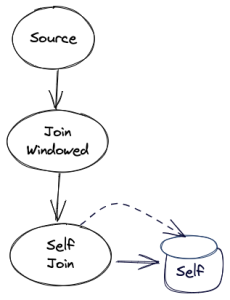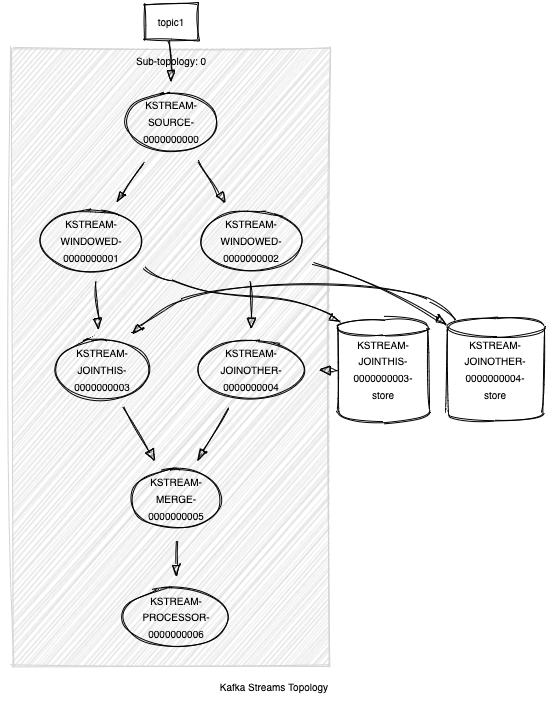...
This page is meant as a template for writing a KIP. To create a KIP choose Tools->Copy on this page and modify with your content and replace the heading with the next KIP number and a description of your issue. Replace anything in italics with your own description.
Status
Current state: [One of "Under Discussion", "Accepted", "Rejected"]
Discussion thread: : https://lists.apache.org/thread/g211rn7j09z1cgrspz0kstxqkkbwfpq9
Voting thread: https://lists.apache.org/thread/shxrhyxlt87rpc64d0xlbkndr6hy9oyhhere [Change the link from the KIP proposal email archive to your own email thread]
JIRA:
| Jira | ||||||
|---|---|---|---|---|---|---|
|
Please keep the discussion on the mailing list rather than commenting on the wiki (wiki discussions get unwieldy fast).
Motivation
A self-join is a join whose left and right-side arguments are the same entity (a stream reading from the same topic). Although self-joins are currently supported in Streams, their implementation is inefficient as they are implemented like regular joins where a state store is created for both left and right join arguments. Since both of these arguments represent the same entity, we don't need to create two state stores (as they will contain the exact same data) but only one. This optimization is only suitable for inner joins whose join condition is on the primary key. We do not consider foreign-key joins as we would need to create a state store for both arguments in order to be able to do efficient lookups. Hence, we will handle foreign-key self joins as regular inner foreign-key joins. Moreover, we do not consider outer joins since we are focusing on primary key joins and there will always be at least one join result, the current record joining with itself.
One should consider this work as a logical plan optimization rule. If the graph contains a join whose arguments are the same entity, then we will rewrite it by applying the aforementioned self-join optimization that will create only one state store.
This optimization only applies to Stream-Stream inner joins. A Table-Table inner self-join would not yield interesting results since a row would always join with itself. Moreover, this optimization does not apply to N-way self-joins as in the current implementation, an inner join is a binary operator. What this entails is that first in the beginning one self-join will be applied whose results contains contain records whose columns are the concatenation of the columns of the left and right join arguments. The subsequent join would then be applied on the result of the first join (the concatenated rows) and not on the inputs of the previous join original input which means it won't be a self-join anymore. In order to optimize N-way self-joins, we would need to implement a new n-ary operator which is out of the scope of this KIP.
Public Interfaces
No public interfaces will be impacted. We will introduce the config SELF_JOIN
TheconfigTOPOLOGY_OPTIMIZATION_CONFIG that enables/disables the optimization. It will only take effect if the config TOPOLOGY_OPTIMIZATION_CONFIG is enabledwill be extended to accept a list of optimization rule configs in addition to the global values "all" and "none" . The new optimization configs a user can provide are:
- merge.repartition.topics
- reuse.ktable.source.topics
- single.store.self.join
The config can either have the values "all", "none" or any of the three rules above. It cannot combine "all" or "none" with any other config.
Proposed Changes
The changes required to implement this proposal are:
...
The algorithm to identify whether two streams represent the same entity will check that :
...
the
...
StreamSourceNode node has a single parent
...
If all these conditions hold, then the join can be optimized as a self join.
- Implement the self-join operator
The self-join operator will maintain one state store. For every new record, the record will first get added operator will add it to the state store and then the operator will use it to perform a lookup into the same state store to do the actual join. This means that every record will at least join with itself.
- Add a rule to the optimizer that will rewrite an inner join to a self-join. The graph graphs (logical planplans) created from the DSL excerpts above are the same (after the already existing optimization
mergeDuplicateSourceNodes) and look as follows:
...
The self-join rewriting will take the above graph, and will translate it into the following topology instead:
Compatibility, Deprecation, and Migration Plan
...
The change is backward compatible since:
- It reuses existing topics/state stores
- It does not change the names of existing topics/state stores
- It removes from the topology the right-side state store but this state store is kept around in case users want to roll back.
- It does not change the internal naming of processors or graph nodes
Here is an example topology of an inner join and how it gets rewritten:
| Code Block |
|---|
Topologies:
Sub-topology: 0
Source: KSTREAM-SOURCE-0000000000 (topics: [topic2])
--> KSTREAM-WINDOWED-0000000001, KSTREAM-WINDOWED-0000000002
Processor: KSTREAM-WINDOWED-0000000001 (stores: [KSTREAM-JOINTHIS-0000000003-store])
--> KSTREAM-JOINTHIS-0000000003
<-- KSTREAM-SOURCE-0000000000
Processor: KSTREAM-WINDOWED-0000000002 (stores: [KSTREAM-JOINOTHER-0000000004-store])
--> KSTREAM-JOINOTHER-0000000004
<-- KSTREAM-SOURCE-0000000000
Processor: KSTREAM-JOINOTHER-0000000004 (stores: [KSTREAM-JOINTHIS-0000000003-store])
--> KSTREAM-MERGE-0000000005
<-- KSTREAM-WINDOWED-0000000002
Processor: KSTREAM-JOINTHIS-0000000003 (stores: [KSTREAM-JOINOTHER-0000000004-store])
--> KSTREAM-MERGE-0000000005
<-- KSTREAM-WINDOWED-0000000001
Processor: KSTREAM-MERGE-0000000005 (stores: [])
--> KSTREAM-PROCESSOR-0000000006
<-- KSTREAM-JOINTHIS-0000000003, KSTREAM-JOINOTHER-0000000004
Processor: KSTREAM-PROCESSOR-0000000006 (stores: [])
--> none
<-- KSTREAM-MERGE-0000000005 |
Self-join topology:
| Code Block |
|---|
Topologies:
Sub-topology: 0
Source: KSTREAM-SOURCE-0000000000 (topics: [topic1])
--> KSTREAM-WINDOWED-0000000001
Processor: KSTREAM-WINDOWED-0000000001 (stores: [KSTREAM-JOINTHIS-0000000003-store])
--> KSTREAM-MERGE-0000000005
<-- KSTREAM-SOURCE-0000000000
Processor: KSTREAM-MERGE-0000000005 (stores: [KSTREAM-JOINTHIS-0000000003-store])
--> KSTREAM-PROCESSOR-0000000006
<-- KSTREAM-WINDOWED-0000000001
Processor: KSTREAM-PROCESSOR-0000000006 (stores: [])
--> none
<-- KSTREAM-MERGE-0000000005 |
As you can see, none of the indices or names of the process is affected.
Rejected Alternatives
Add to the DSL the operator selfJoin. We did not go with this approach as we prefer to push the complexity of the optimization to streams instead of to the user.
...


